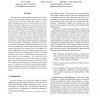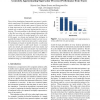225 search results - page 1 / 45 » A Predictive Performance Model for Superscalar Processors |
MICRO
2006
IEEE
14 years 3 months ago
2006
IEEE
Designing and optimizing high performance microprocessors is an increasingly difficult task due to the size and complexity of the processor design space, high cost of detailed si...
ISPASS
2009
IEEE
14 years 4 months ago
2009
IEEE
Trace-driven simulation of superscalar processors is particularly complicated. The dynamic nature of superscalar processors combined with the static nature of traces can lead to l...
CF
2010
ACM
14 years 2 months ago
2010
ACM
We develop two simple interval-based models for dynamic superscalar processors. These models allow us to: i) predict with great accuracy performance and power consumption under va...
ICCD
1996
IEEE
14 years 1 months ago
1996
IEEE
There are four crucial issues associated with performance simulators: simulator retargetability, simulator validation, simulation speed and simulation accuracy. This paper documen...
HPCA
1999
IEEE
14 years 1 months ago
1999
IEEE
Control independence has been put forward as a significant new source of instruction-level parallelism for future generation processors. However, its performance potential under p...


